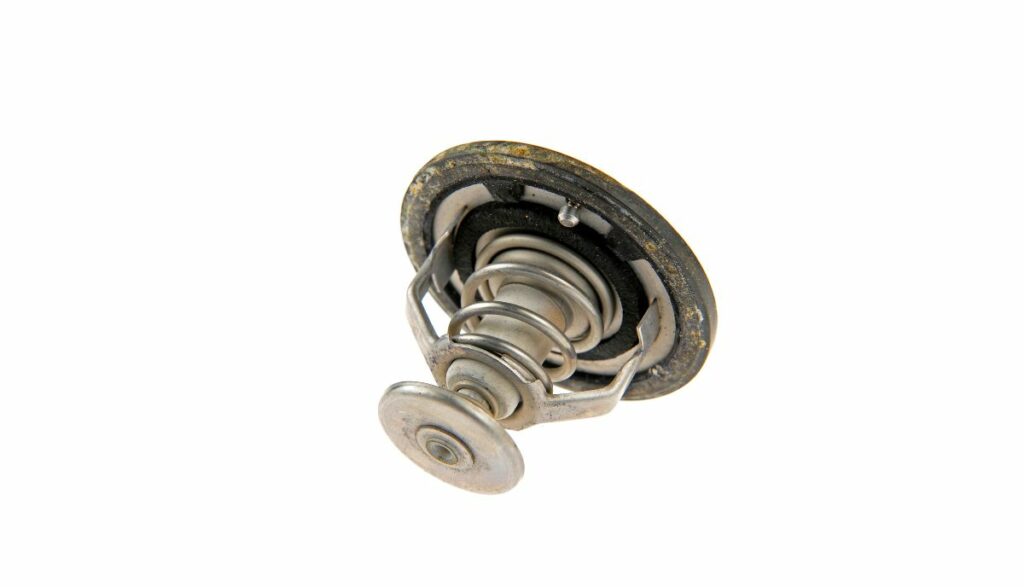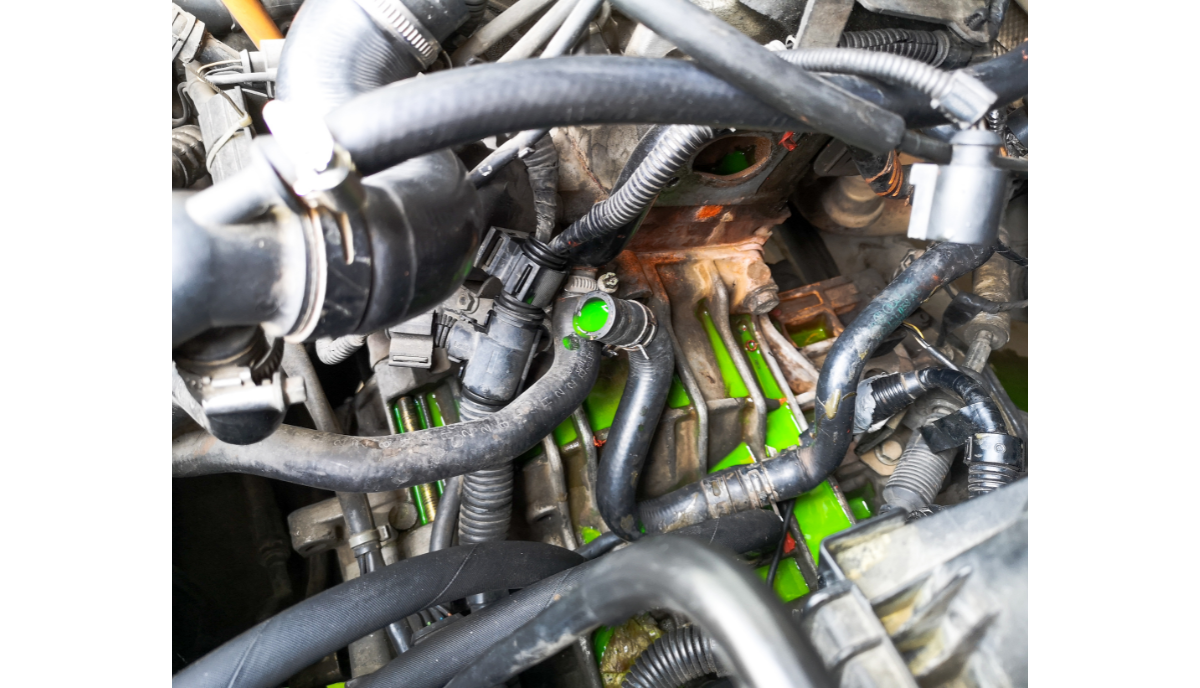The thermostat controls the coolant flow. Because the substance moves through a closed circuit, laypeople don’t expect a defective thermostat to affect the coolant levels. However, it should be noted that a bad thermostat affects the engine’s temperature.
A cool engine (resulting from a thermostat stuck open) is not an immediate problem. The threat emerges from a closed thermostat that allows the heat to increase. This creates leaks in the hoses, water pumps, and radiator, allowing the coolant to escape. Additionally, the coolant can boil over and escape from the overflow tank because of high engine temperatures.
When a thermostat fails, you can expect one or more of the following symptoms:
- The ‘Check Engine’ lights, warnings, and codes will illuminate and flash.
- The coolant will leak.
- The temperature gauge will swing into the red in response to the high temperatures under the hood.
- The engine will generate knocking and rumbling sounds.
- The heater may refuse to work because the engine can’t generate enough heat. This happens when the thermostat sticks in the open position and the coolant flows continuously, stealing the engine’s heat.
As you can see, a coolant leak is included among those symptoms. However, the other symptoms are just as important because they can indirectly lower the coolant levels in your car.
Unfortunately, automotive coolant can leak for various reasons, many of them unrelated to the thermostat. The guide below will show you how to identify thermostat-related coolant leaks:
How A Malfunctioning Thermostat Can Disrupt Coolant Movement?

According to this paper in the International Journal of Heat And Mass Transfer (S.C. Pang, M.A. Hazrat, M.A. Kalam, H.H. Masjuki), the cooling system maintains normal operating temperatures by circulating coolant through the engine.
The coolant picks up and carries the heat away. But how does the coolant know when to flow? This 2019 paper in the International Research Journal of Engineering and Technology answers that question. The thermostat responds to the engine’s temperature. When the engine is cold, the thermostat remains closed. This prevents the coolant from flowing.
You want the thermostat to keep the coolant away when you start a vehicle because the engine needs to warm up. You don’t want the coolant to steal the heat. The heat will continue to increase until the engine attains optimal operating temperatures.
Again, at this point, the thermostat will remain closed. Unfortunately, the heat won’t stop here. It will continue to climb until it threatens the health and integrity of the engine’s parts. The thermostat will respond by opening and allowing the coolant to flow.
In that regard, the thermostat controls the coolant flow directly. It can either permit or prevent the coolant from moving through the engine, depending on the conditions it encounters under the hood.
Different thermostats have different temperature ratings. As such, they will open and close at different temperatures. You can restrict the coolant’s ability to control the engine’s temperature by installing a thermostat with the wrong rating.
The Link Between Restricted Flow And Possible Leaks
Coolant leaks are fairly common. The substance flows within a closed system. Therefore, you don’t expect coolant levels to drop unless a leak springs because of the following factors:
- The coolant flows through hoses that link to the different parts of the engine. Those hoses can tear and rupture, permitting the coolant to spill out.
- The radiator is another common cause of coolant leaks. According to The Federal Group USA, coolant flows through the engine block and head before running to the radiator, where it cools. Then, it continues its journey through the engine block. If the radiator corrodes, the coolant will escape.
- The water pump circulates the coolant through the engine. So naturally, a defect in the water pump can cause a coolant leak.
On the surface, none of those factors are connected to the thermostat. But that is only true if you’re searching for a direct association. Indirectly, a thermostat can create leaks in the radiator, hoses, and water pump if it sticks in the closed position.
By remaining closed, the thermostat prevents the coolant from flowing. This allows the engine to overheat, which, in turn, damages the radiator, hoses, and water pump to a point where they develop leaks.
A layperson is unlikely to connect a stuck thermostat to a coolant leak because they don’t realize that thermostats can restrict the coolant flow. You need an experienced mechanic to diagnose this problem. Otherwise, it may go unnoticed.
How A Closed Thermostat Might Elevate Pressure?
Cars and their engines have an interesting relationship with the pressure. Consider the following:
- Boiling Point
High pressure increases the coolant’s boiling point. Thermostat flow restriction makes the coolant in the water pump less likely to boil. Although this doesn’t help in keeping the engine cool.
This particular situation is concerned with an engine that generates so much heat that the vehicle starts relying on the radiator and an optimal airflow rate to keep the engine cool. In such a scenario, the thermostat is completely open because the coolant has too much heat.
- Radiator Cap
The pressure is usually the responsibility of the radiator cap. It protects the hoses and radiator by allowing air and coolant to escape when the internal pressure builds to unsafe levels. The cap can malfunction because of variables such as rust and the wrong pressure rating, causing the pressure to build.
While you can’t rule it out, a bad thermostat is unlikely to harm the radiator cap. That doesn’t include cases where the thermostat ruins the radiator through overheating, which indirectly damages the radiator cap.
- Overheating
High temperatures are the most prominent concern. Overheating in the engine can elevate the pressure to a point where it breaks the seals and gaskets.
Effects Of Increased Pressure On Gaskets And Potential Leaks
A defective thermostat can directly cause coolant leaks by damaging the thermostat housing. As the name suggests, the housing holds the thermostat. Whether the housing is standalone or integrated depends on the vehicle. Overheating and increased pressure will attract the following consequences:
1). Cracked Housing
The housing can crack or break, allowing the coolant to spill out. Plastic housings are particularly vulnerable to the heat. They can warp under the strain. However, cracks can also emerge because a mechanic applied too much torque while installing the thermostat. Don’t be so quick to blame the thermostat.
2). Seals/Gaskets Wear Out
The housing uses seals and gaskets to create a secure connection. Those seals and gaskets wear out naturally over the months and years. But the heat and excess pressure from a faulty thermostat can accelerate that wear and tear.
Once the seals and gaskets fail, the coolant will leak. The severity of the damage will determine the extent of the leaks.
Symptoms That Suggest A Thermostat-Related Coolant Leak
You can tell that coolant is leaking from your car because you will notice the following symptoms:
- The coolant level in the reservoir will drop.
- The engine will overheat.
- You will notice a sweet scent.
- You will see puddles of coolant on the ground whenever you park the car.
- The exhaust pipe will eject white smoke.
- If your vehicle has a coolant warning light, it will illuminate.
These symptoms will tell you that the coolant is leaking. They won’t tell you what caused the leak. You can’t identify thermostat-related coolant leaks using visible signs, not without opening the hood, retrieving the thermostat, and testing it.
Diagnosing Coolant Leaks Associated With The Thermostat.
- Idle the car and check the temperature gauge. Low temperatures point to a thermostat stuck open. The coolant keeps flowing and stealing the engine’s heat. High temperatures manifest when the thermostat is stuck in the closed position.
- Confirm your suspicions by opening the hood and removing the radiator cap. You should see the coolant flowing after idling the engine for 20 minutes. If the coolant starts flowing when you start the car, the thermostat is stuck open. If the coolant refuses to flow through the radiator after running the engine for several minutes, the thermostat is stuck closed.
- Aim an infrared thermometer at the radiator hose. A cold hose means the thermostat is stuck closed.
- Place the thermostat in hot water to see if it opens.
As you can see, your primary task is determining whether the thermostat is stuck in the closed position. If the thermostat opens and closes as expected, look elsewhere for the source of the leaks.
Distinguishing Coolant Leaks Caused By A Bad Thermostat From Other Factors
- Check the temperature gauge. If the gauge is in the red, the engine is too hot.
- The ‘Check Engine’ light will also illuminate to warn you. This should encourage you to open the hood and search for the source of the leak.
- Confirm that leaks have occurred by looking for puddles beneath the car.
- You should also check the reservoir. If the coolant levels are sufficient, the vehicle is overheating for other reasons. If the coolant levels are low, the coolant leak is responsible for the excess heat.
- Wear protective gear and remove the radiator cap (once the engine cools). Is it worn out, stuck, corroded, or covered in dirt and debris?
- Inspect the water pump for leaks. If it seems okay, what about the belt (assuming a belt drives the water pump)? You should also check the pulley.
- Look at the hose. Do you see cracks and ruptures?
- Is the gasket damaged? A blown gasket allows the coolant to escape.
- Some mechanics will add more coolant to the reservoir, run the engine, and inspect every component for streaks of leaking antifreeze.
- You can also deploy a pressure tester.
If you rule out all the obvious causes of leaking coolant, test the thermostat, either with a multimeter or by taking it out and determining whether it opens in hot water. A visual inspection may reveal physical defects.

